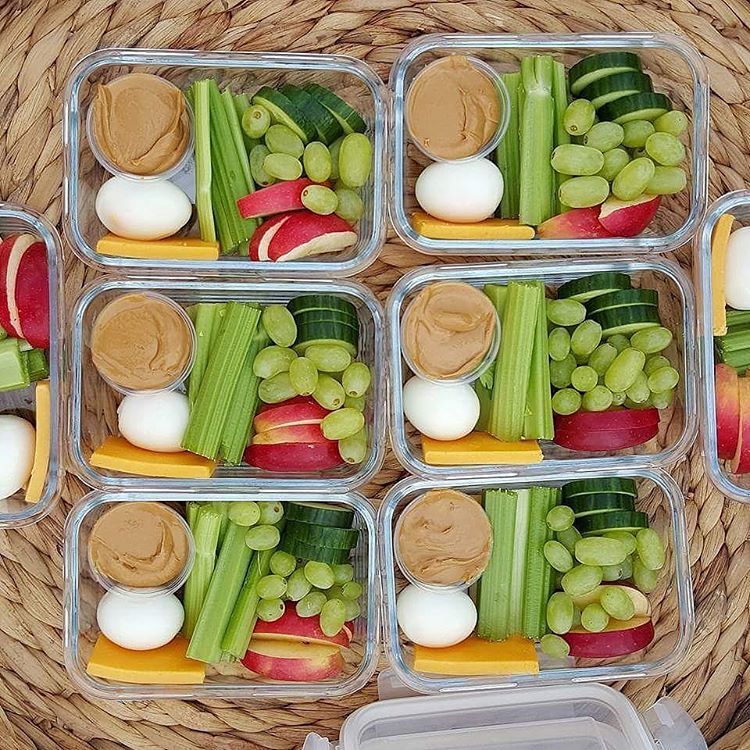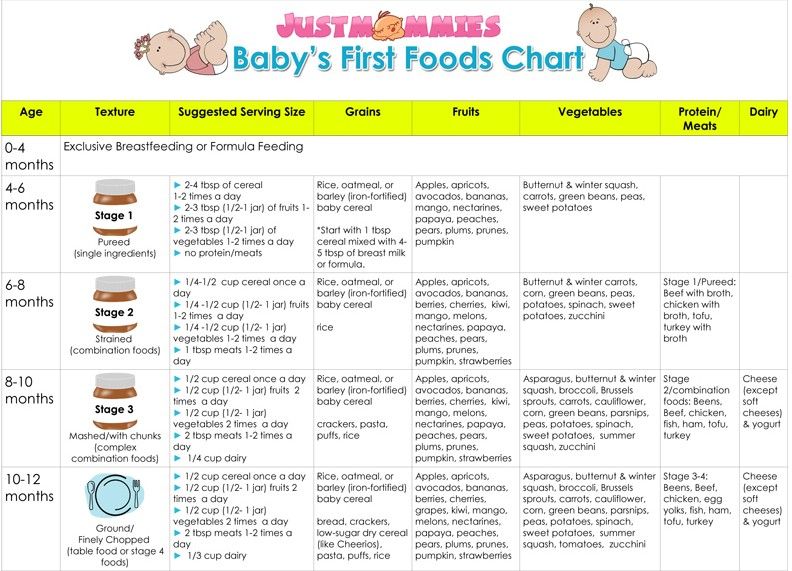Easy baby feeding schedule
Tips for the First Year
Eat, sleep, pee, poop, repeat. Those are the highlights in a day of the life of a brand new baby.
And if you’re a new parent, it’s the eating part that may be the source of many of your questions and worries. How many ounces should your baby take? Do you wake a sleeping baby to eat? Why do they seem hungry all the time? When can your child start solids?
Questions abound — and, despite Grandma’s insistence, the answers have changed since you were a tot. It’s now recommended that newborns, even formula-fed ones, eat on demand (consider it good preparation for the teenage years) and that babies wait to start solid foods until they’re 4 to 6 months old.
On day one of life, your baby’s stomach is the size of a marble and can only hold 1 to 1.4 teaspoons of liquid at a time. As your baby gets older, their stomach stretches and grows.
It’s hard (or impossible, really) to know how much milk your baby is taking in while breastfeeding. But if you’re bottle feeding due to any number of valid reasons, it’s a bit easier to measure.
Here, from the American Academy of Pediatrics (AAP), a typical feeding schedule for bottle-fed babies.
| Age | Ounces per feeding | Solid foods |
|---|---|---|
| Up to 2 weeks of life | .5 oz. in the first days, then 1–3 oz. | No |
| 2 weeks to 2 months | 2–4 oz. | No |
| 2–4 months | 4-6 oz. | No |
| 4–6 months | 4–8 oz. | Possibly, if your baby can hold their head up and is at least 13 pounds. But you don’t need to introduce solid foods yet. |
| 6–12 months | 8 oz. | Yes. Start with soft foods, like one-grain cereals and pureed vegetables, meats, and fruits, progressing to mashed and well-chopped finger foods. Give your baby one new food at a time. Continue supplementing with breast or formula feedings.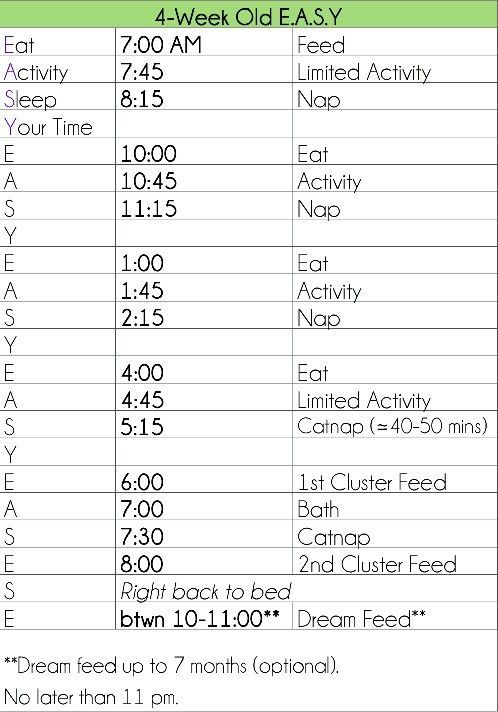 |
Every baby is unique — but one thing that’s pretty consistent is that breastfed babies eat more frequently than bottle-fed ones. That’s because breast milk is easily digested and empties from the stomach a lot quicker than formula.
Breastfed babies
There’s no rest for the weary. According to La Leche League International, you should begin nursing your baby within 1 hour of birth and provide about 8 to 12 feedings daily in the first few weeks of life (yeah, we’re exhausted for you).
At first, it’s important not to let your baby go more than 4 hours without feeding. You’ll likely need to wake them up if necessary, at least until breastfeeding is well established and they’re gaining weight appropriately.
As your baby grows and your milk supply amps up, your baby will be able to take in more milk in less time at one feeding. That’s when you might start to notice a more predictable pattern.
- 1 to 3 months: Your baby will feed 7 to 9 times per 24 hours.

- 3 months: Feedings take place 6 to 8 times in 24 hours.
- 6 months: Your baby will feed around 6 times a day.
- 12 months: Nursing may drop to about 4 times a day. The introduction of solids at about 6 months helps to fuel your baby’s additional nutritional needs.
Keep in mind that this pattern is just one example. Different babies have different paces and preferences, along with other factors that influence the frequency of feedings.
Bottle-fed babies
Like breastfed babies, bottle-fed newborns should eat on demand. On average, that’s about every 2 to 3 hours. A typical feeding schedule may look like this:
- Newborn: every 2 to 3 hours
- At 2 months: every 3 to 4 hours
- At 4 to 6 months: every 4 to 5 hours
- At 6+ months: every 4 to 5 hours
For both breastfed and bottle-fed babies
- Don’t give liquids other than formula or breast milk to babies under a year old. That includes juices and cow’s milk.
 They don’t provide the right (if any) nutrients and can be upsetting to your baby’s tummy. Water can be introduced around 6 months when you start offering a cup.
They don’t provide the right (if any) nutrients and can be upsetting to your baby’s tummy. Water can be introduced around 6 months when you start offering a cup. - Don’t add baby cereal to a bottle.
- It can create a choking hazard.
- A baby’s digestive system isn’t mature enough to handle cereal until about 4 to 6 months of age.
- You could overfeed your baby.
- Don’t give your baby any form of honey until after their first birthday. Honey can be dangerous for a baby, occasionally causing what’s called infant botulism.
- Do adjust your expectations based on your baby and their unique needs. Premature babies are likely to follow feeding patterns according to their adjusted age. If your baby has challenges like reflux or failure to thrive, you may need to work with your doctor on the appropriate feeding schedule and amount they should be eating.
Schedules are the holy grail of every parent. Your child will naturally start to fall into a feeding pattern as their tummy grows and they can take in more breast milk or formula at one sitting. This may begin to happen between 2 and 4 months of age.
This may begin to happen between 2 and 4 months of age.
For now, though, focus on learning your baby’s hunger cues, such as:
- rooting around your chest, looking for a nipple.
- putting their fist in their mouth
- smacking or licking their lips
- fussing that can escalate quickly (don’t wait until your baby’s hangry to feed them)
Once your baby is a few months old, you may be able to introduce a sleep/feed schedule that works for you.
Let’s say, for example, your 4-month-old wakes every 5 hours for a feeding. That means if you feed at 9 p.m., your baby wakes around 2 a.m. But if you wake and feed the baby at 11 p.m., just before you go to bed, they may not rouse until 4 a.m., giving you a decent chunk of nighttime winks.
In general, if your baby seems hungry, feed them. Your baby will naturally eat more frequently during growth spurts, which typically occur around 3 weeks, 3 months, and 6 months of age.
Some babies will also “cluster feed,” meaning they’ll feed more frequently during certain periods and less at others. For example, your baby may cluster feed during the late afternoon and evening and then sleep longer at night (yay!). This is more common in breastfed babies than bottle fed babies.
For example, your baby may cluster feed during the late afternoon and evening and then sleep longer at night (yay!). This is more common in breastfed babies than bottle fed babies.
Worried about overfeeding? While this isn’t really possible to do with an exclusively breastfed baby, you can overfeed a baby who’s taking a bottle — especially if they’re sucking on the bottle for comfort. Follow their hunger cues, but talk to your pediatrician if you’re worried your little one may be overeating.
Your baby is probably ready for solids if they’re 4 to 6 months old and:
- have good head control
- seem interested in what you’re eating
- reach for food
- weigh 13 or more pounds
Which food to start with? The AAP now says it doesn’t really matter much in what order you introduce foods. The only real rule: Stick with one food for 3 to 5 days before offering another. If there’s an allergic reaction (rash, diarrhea, vomiting are common first signs), you’ll know which food is causing it.
As your baby grows, move from pureed baby food to ones that have more texture (for example, mashed banana, scrambled egg, or well-cooked, chopped pasta). This generally happens around 8 to 10 months of age.
Your supermarket offers a variety of baby food products, but if you want to make your own, keep it sugar and salt free. Additionally, at this stage, don’t feed your baby anything that could be a choking hazard, including:
- hard foods, such as popcorn or nuts
- hard, fresh fruits, like apples; cook to soften or chop into very small pieces
- any meat that isn’t well cooked and very well chopped (this includes hot dogs)
- cheese cubes
- peanut butter (though talk to your pediatrician about this one — and the benefits of introducing diluted peanut butter before the age of 1)
As your baby nears their first birthday, they should be eating a variety of foods and taking in about 4 ounces of solids at each meal. Continue to offer breast milk or formula.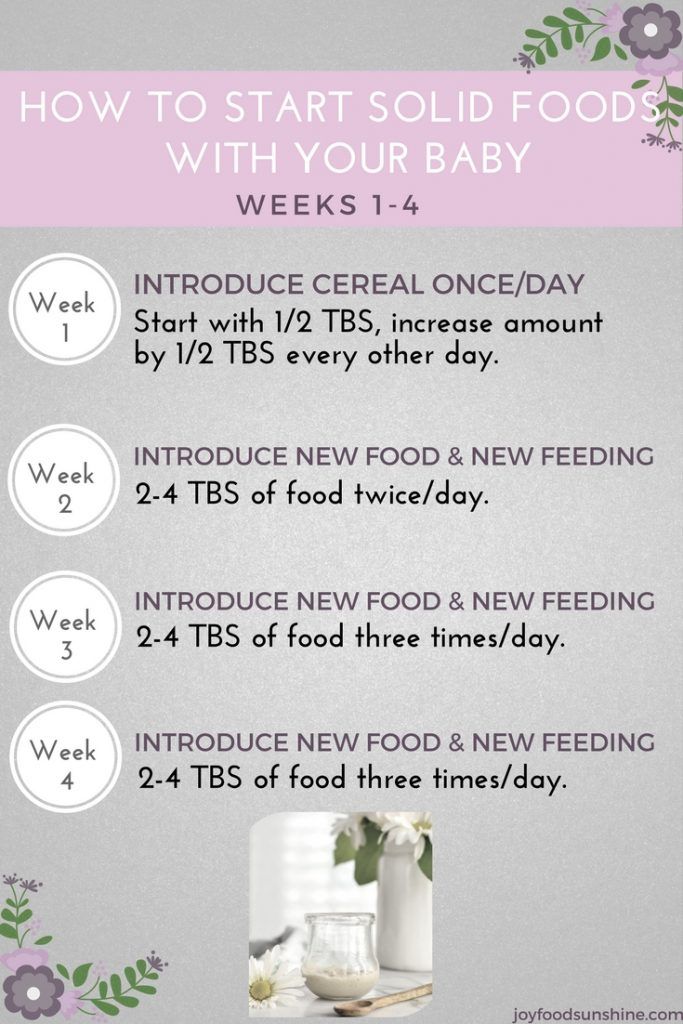 By 8 months, babies are drinking about 30 ounces a day.
By 8 months, babies are drinking about 30 ounces a day.
Oh yeah, and buy some stock in a company that makes stain-fighting laundry detergent. It’ll pay for college.
Babies aren’t cookie cutter. Some will gain weight easily, while others will have problems. Things that can affect a baby’s weight gain include:
- having a birth defect like a cleft lip or palate, which creates problems feeding
- having a milk protein intolerance
- being premature
- being fed with a bottle versus the breast
A 2012 study of more than 1,800 babies found that the infants who were fed with a bottle — regardless of whether the bottle contained breast milk or formula — gained more weight in the first year than babies who nursed exclusively.
Your baby’s doctor is the best one to advise you on a healthy weight range for your baby.
How, when, and what to feed a baby are top worries of every parent — but there’s good news: Most babies are pretty good judges of when they’re hungry and when they’re full — and they’ll let you know it.
You just need to present them with the right choices at the right time and pay attention to their cues. If you have any questions or concerns, your pediatrician is there to help you along the way.
The EASY Sleep Schedule For Your Baby Ready, Set, Food!
The EASY method is a baby routine with a dedicated order for eating, playtime, and sleep, as well as time for the parent or caregiver to have to themselves. Here's what you need to know about using the EASY method.
Is there a way to help baby sleep through the night, and claim precious time for yourself? Parents often believe that baby's sleep patterns are down to luck (with some help from the environment). But many parents have found success with a baby routine called the EASY Method. Today, we'll break down what the EASY method is and how to use it.
What is the EASY Method?
The EASY method is a baby routine with a dedicated order for eating, playtime, and sleep, as well as time for the mother or caregiver to have to themselves. This method was developed by Tracy Hogg, author of the book Secrets of the Baby Whisperer.
This method was developed by Tracy Hogg, author of the book Secrets of the Baby Whisperer.
When you follow the EASY method, you never feed baby on demand. Instead, you guide baby through their daily routine in a specific order:
- Eat
- Activity (playtime)
- Sleep
- Your Time (time for the parent, while the baby is sleeping)
Once baby wakes up, you then follow the sequence again, starting with eating. Then, you'll go through the sequence as many times as needed throughout the day.
Learn more about the EASY method from Bumps to Bundles & Giggles to Tumbles:
Does it matter how often baby eats and sleeps in this method?
Every baby is different, so every baby will take different amounts of time to eat and sleep. And often, baby's eating and sleep amounts will change as they grow. Don't worry if baby seems like they're sleeping less, or if there are longer gaps between feeds.
And often, baby's eating and sleep amounts will change as they grow. Don't worry if baby seems like they're sleeping less, or if there are longer gaps between feeds.
The exact times of day, eating amounts, and sleeping amounts don't matter in this method, as long as you always follow the EASY order for when baby should eat and sleep in sequence. If you follow the steps, baby will still grow and thrive--- and you'll reclaim at least some valuable time for yourself. Now, let's go through each of the steps of the EASY routine in sequence.
E: Eat
Just what it sounds like, these are the times when you feed baby breastmilk or formula (or solids, once they're ready).
For the first few months of baby's life, though, the EASY routine also includes two important evening and night feeds--- the cluster feed and dream feed. These two types of feeds are key in keeping baby satisfied so they'll sleep through the night.
Cluster Feed
The "cluster feed" involves feeding baby around 2 hours apart in the evening, before bed.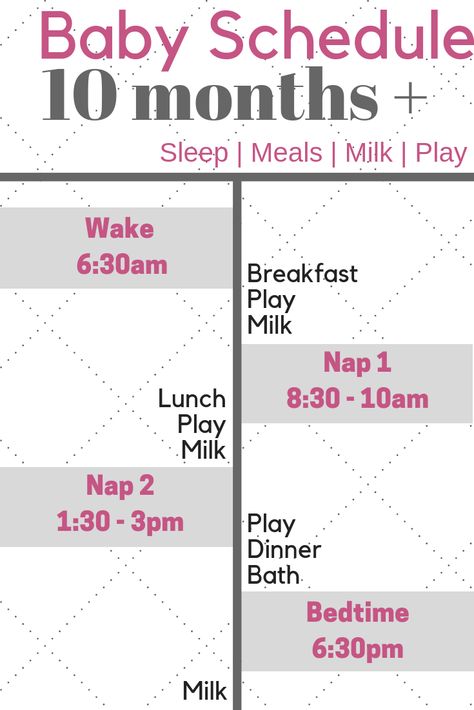 After the first cluster feed, you'll have baby do an activity (such as tummy time or engaging them while in their bath) and take a catnap. Then, after the second cluster feed, you'll put baby right to bed.
After the first cluster feed, you'll have baby do an activity (such as tummy time or engaging them while in their bath) and take a catnap. Then, after the second cluster feed, you'll put baby right to bed.
For example, you might cluster feed baby for the first time at 6 PM, do an activity, have baby catnap, then do the second cluster feed at 8 PM before putting baby to bed. Cluster feeds are usually done through baby's second month, then added back in between 4 and 6 month if your baby experiences a growth spurt.
Dream Feed
During the dream feed, you feed baby during the night while they're still asleep. Feeding baby like this without waking them up will help them sleep better through the rest of the night---hopefully, without waking in the middle of the night, so you can enjoy more precious sleep. During the dream feed, you must make sure they're just conscious enough to latch onto and suck the breast or bottle, without rousing them. The dream feed should take place between 10PM and midnight (no later than midnight).
A: Activity
After feeding baby, doing an activity with them will engage them and help promote healthy development of movement and cognitive skills. Being physically and mentally busy will also help tire them out so they're ready for a nap!
Baby activities could include tummy time, bath time, reading to baby, singing to baby, taking baby outside, or giving baby a toy to play with. Diaper changes should also take place during activity time. For the very youngest babies, giving them a toy or mobile to stare at, or talking to/cooing at them count as activities.
Just don't overdo the activity. You don't want baby to be so wired that they refuse to nap.
S: Sleep
Sleep is essential for baby's growth and brain development. Babies' naps can range from 20 minutes (early on and for catnaps) to 2 hours. Napping throughout the day will help your baby sleep at night, but if baby naps too long throughout the day, they'll likely have trouble sleeping through the night. Especially watch the last two naps of the day--- if baby sleeps too long during these naps, they might be wide awake at bedtime.
Especially watch the last two naps of the day--- if baby sleeps too long during these naps, they might be wide awake at bedtime.
Y: Your Time
Once baby is sleeping, savor the precious and valuable time to do whatever you want! Call a friend, watch a favorite show, read, catch up on social media, take a bath, or recharge with a nap of your own.
Sample EASY Schedules
The website Noob Mommy has put together sample EASY schedules for babies ages 4 weeks-1 year of age.
As you'll see in the schedules, as baby gets older, they should be able to go longer between feeds (at approximately 4-6 months, they should be able to go 4 hours between feeds.)
Then, once baby starts eating solids, you'll need to adjust the "eat" parts of the schedule for giving both the solids and breastmilk/formula.
Again, don't feel like you have to follow an exact schedule. The schedules linked above are just meant to be examples of how to apply the EASY method.
When should you start the EASY routine?
The earlier in life you start, the easier it will be to establish the EASY routine, because it's less likely that your baby has already fallen into another routine.
You can start to apply the EASY routine as soon as baby gets home from the hospital.
But it may be best to start the EASY routine around one month of age, after you know how much breastmilk or formula baby needs to be full without overfeeding.
If your baby's over a month old, though, don't fret. You can still apply the EASY routine anytime before 9 months of age.
When does the EASY Routine no longer make sense?
At around 9 months of age, baby should consistently eat three meals a day with two snacks, and go 5 hours in between main meals. Keeping baby on a schedule will still help, but it won't exactly follow the EASY pattern.
Then, shortly after their first birthday, baby will usually only need one long nap in addition to their nighttime sleep, so the EASY routine will no longer make sense.
--------------------------------
All health-related content on this website is for informational purposes only and does not create a doctor-patient relationship. Always seek the advice of your own pediatrician in connection with any questions regarding your baby’s health.
Always seek the advice of your own pediatrician in connection with any questions regarding your baby’s health.
These statements have not been evaluated by the Food and Drug Administration. Products are not intended to diagnose, treat, cure or prevent any disease.
See the FDA Peanut Allergy Qualified Health Claim at the bottom of our homepage.
what can be given and how often to feed
You can't even imagine how much feeding a baby for months affects the baby growing up healthy and happy.
It is up to the pediatrician to determine exactly how to feed the little one. But it is also useful for a young mother to be able to independently understand all the nuances.
Monthly feeding schedule for children under one year old
A child should be accustomed to a monthly feeding schedule almost immediately, at the very beginning of his life. Such a daily routine is understood as a specific meal plan when the baby eats food at approximately the same time. It will be convenient for parents and useful for their toddler. nine0005
It will be convenient for parents and useful for their toddler. nine0005
Thanks to this, the little man grows up healthy, strong, disciplined and easily adapts to society. Well, a mother who has accustomed her child to a clear diet can plan her day more freely and allocate time for herself and good rest.
Top 3 things to keep in mind when scheduling your baby's feeding by months:
- Individual approach, namely the biological rhythms of your little one. Make compromises: your breastfeeding schedule should not be at odds with the needs of the baby, but it should also be comfortable for the mother. nine0020
- Flexibility. Simply put, the daily routine, which was relevant in the first weeks of life, can be gradually adjusted in a way that will be more correct and beneficial for the growing toddler.
- Sequence. Take your time: any changes should be smooth and consistent. If you suddenly change the time of eating, it will be difficult for the baby to adapt to this.
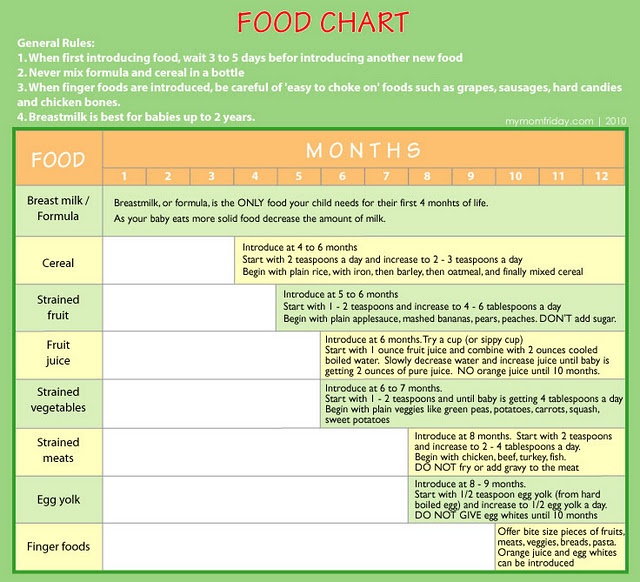
Keep in mind that the optimal interval between meals is 2-3 hours. As you grow and develop, you will gradually reduce the number of meals and increase the interval between them, as well as wean the baby from nighttime snacking. nine0005
To ensure that meals are as enjoyable as possible and that the little man can fully concentrate on food, make sure that he has cozy clothes for newborns. She will give the little one the desired comfort and convenience, so it will be easier for you to accustom your child to the correct daily routine.
In Demi's online store you will find a large selection of baby clothes for newborns made of knitwear, a high-quality natural fabric that your baby will definitely like. nine0005
For your convenience, we have prepared a monthly feeding chart for your baby. You can focus on it, making up the daily routine of the little sun.
| Age | Meals | Time |
|
0-3 months | First | 6:00-6:30 |
| Second | 9:00 | |
| Third | 12:00 | |
| Fourth | 15:00 | |
| Fifth | 18:00 | |
| Sixth | 21:00 | |
| Seventh | 24:00 or 2:00 | |
|
3-6 months | First | 6:00-6:30 |
| Second | 9:30 | |
| Third | 13:00 | |
| Fourth | 16:30 | |
| Fifth | nine0044 ||
| Sixth | 23:30 or 2:00 | |
|
6-9 months | First | 6:00-6:30 |
| Second | 10:00 | |
| Third | 14:00 | |
| nine0045 Fourth | 18:00 | |
| Fifth | 22:00 or 1:00 | |
|
9-12 months | First | 7:00 |
| Second | 11:30 | |
| Third | 16:00 | nine0056 |
| Fourth | 19:00 | |
| Fifth | 24:00 or 2:00 | |
If you prefer to give food on demand, pay attention to the behavior of the little sun. If he cries or screams, this may be a sign that the baby is hungry.
If he cries or screams, this may be a sign that the baby is hungry.
Feeding a baby for months on artificial feeding
When you are breastfeeding your baby, your diet may be looser. But if complementary foods are used in the diet or in the complete absence of lactation, it is preferable to artificially feed the child for months strictly according to the regimen.
Our table will help you navigate:
| Age | Number of meals | Mix volume |
| First week | 7-10 | 700 ml |
| Up to 2 months | 7-8 | 750 ml |
| From 2 to 4 months. | 6-7 | 800 ml |
For babies older than 4 months, you can additionally introduce other food in pureed form. It is advisable to do this when the little man does not mind trying it or shows signs of hunger. nine0005
It is advisable to do this when the little man does not mind trying it or shows signs of hunger. nine0005
At the same time, do not forget that in fact the digestive system is not completely formed until 2 years old, so do not rush to completely transfer your child to a semi-solid diet.
Monthly formula mothers should discuss this with their pediatrician to avoid health problems.
TM Demi wishes all the little ones a quick adaptation to the right diet. Grow healthy!
Breastfeeding schedule
Covering the topic of breastfeeding, it is impossible to ignore such a thing as a feeding regimen. All mothers know that modern doctors recommend feeding the baby on demand. However, what this means, each woman understands in her own way. Some mothers believe that on demand is to feed once every 3 hours, others are sure that on demand means feeding at every rustle, etc. Let's try to understand this difficult topic.
If feeding is considered as an act of feeding, then "on demand" means to feed when the child begins to want to eat. If the child screams a lot, it means that the mother missed the right moment for feeding and the baby wants to eat for a long time. nine0005
If the child screams a lot, it means that the mother missed the right moment for feeding and the baby wants to eat for a long time. nine0005
Signs of hunger
Early signs of hunger:
1. The child's activity increases - the baby wakes up, moves.
2. Search movements are made - the child turns his head left and right, looking for the chest with his mouth.
3. There are various sounds, smacking.
4. The kid brings the hands to his mouth, sucks his fist.
If the mother ignores these manifestations, the baby has no choice but to scream heart-rendingly. The cry of the baby in this case will be a signal for the parents, saying that the child has long needed to eat. nine0005
If the baby is crying, but no signs of hunger were noticeable before, then it is likely that the baby is crying for another reason - due to a dirty diaper, too high or low room temperature, tummy pain, need for sleep etc. Or maybe he just missed his mother and wants to be in her arms.
Therefore, it is better to first check if there are other reasons for crying? Attention! All of the above applies only to older children. nine0005
What about newborn babies?
Newborn babies do not yet have a formed feeling of hunger. These babies are in a state of discomfort. For 9 months of intrauterine development, they are accustomed to living in a calm and warm mother's belly. After that, our world seems to them too loud, too bright, too noisy and cold. The only thing that can reduce this discomfort is the taste of mother's milk and the smell of lubricant produced by the glands on the areola of the nipples. These tastes and smells remind babies of the amniotic fluid they swallowed while in the womb. nine0005
That is why feeding babies in the first month of life is breastfeeding for every squeak. And it doesn’t matter how often this happens - once every 5 minutes or 2 hours after the previous feeding. Both of these options are completely normal.
Breastfeeding is not only a meal, it is an important psycho-emotional bond between mother and baby.



